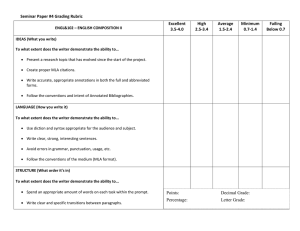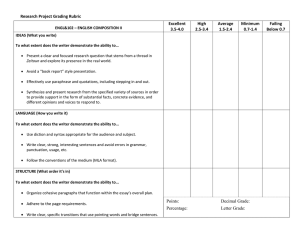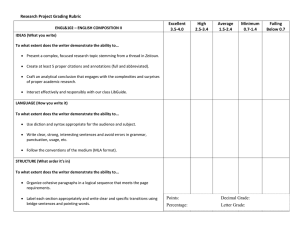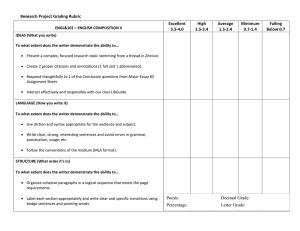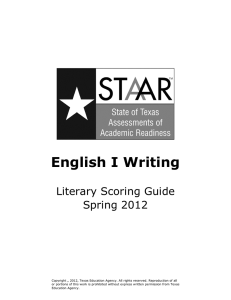Engl 240 Fall 2012
advertisement
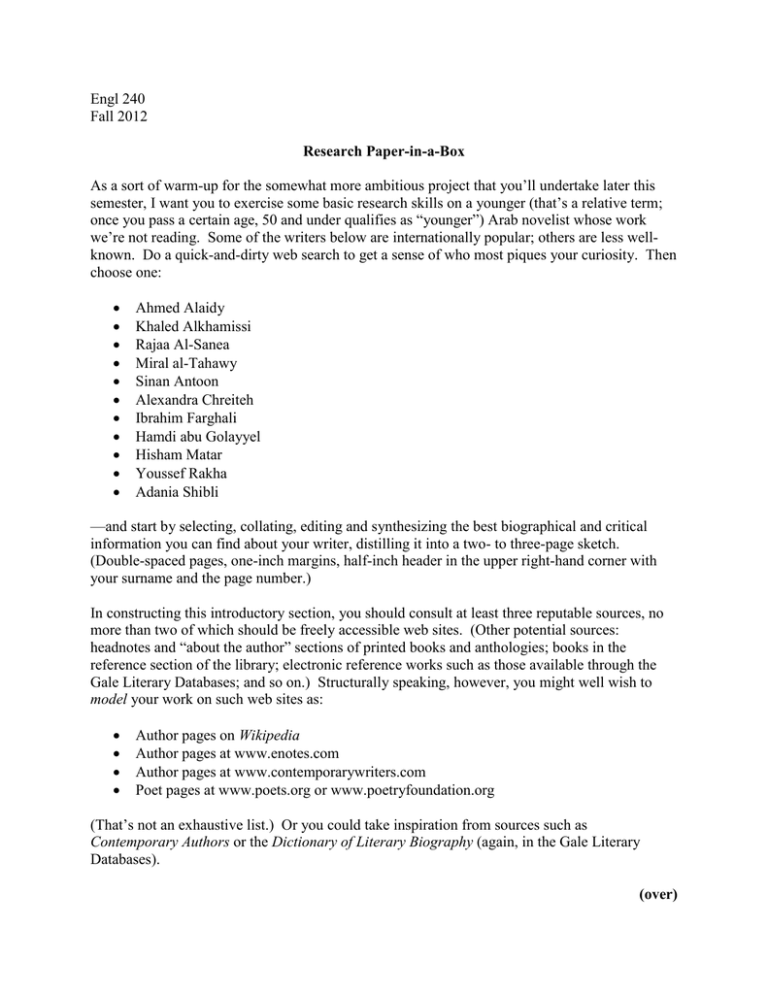
Engl 240 Fall 2012 Research Paper-in-a-Box As a sort of warm-up for the somewhat more ambitious project that you’ll undertake later this semester, I want you to exercise some basic research skills on a younger (that’s a relative term; once you pass a certain age, 50 and under qualifies as “younger”) Arab novelist whose work we’re not reading. Some of the writers below are internationally popular; others are less wellknown. Do a quick-and-dirty web search to get a sense of who most piques your curiosity. Then choose one: Ahmed Alaidy Khaled Alkhamissi Rajaa Al-Sanea Miral al-Tahawy Sinan Antoon Alexandra Chreiteh Ibrahim Farghali Hamdi abu Golayyel Hisham Matar Youssef Rakha Adania Shibli —and start by selecting, collating, editing and synthesizing the best biographical and critical information you can find about your writer, distilling it into a two- to three-page sketch. (Double-spaced pages, one-inch margins, half-inch header in the upper right-hand corner with your surname and the page number.) In constructing this introductory section, you should consult at least three reputable sources, no more than two of which should be freely accessible web sites. (Other potential sources: headnotes and “about the author” sections of printed books and anthologies; books in the reference section of the library; electronic reference works such as those available through the Gale Literary Databases; and so on.) Structurally speaking, however, you might well wish to model your work on such web sites as: Author pages on Wikipedia Author pages at www.enotes.com Author pages at www.contemporarywriters.com Poet pages at www.poets.org or www.poetryfoundation.org (That’s not an exhaustive list.) Or you could take inspiration from sources such as Contemporary Authors or the Dictionary of Literary Biography (again, in the Gale Literary Databases). (over) It should go without saying that cutting and pasting other people’s words won’t do here; neither will minor syntactical rearrangements and strategically placed synonyms. You need to extract the raw ingredients and reassemble them into a fluid narrative of your own, adding commentary, interpretation, and connective tissue as necessary. Append a “Sources” page to this section, with bibliographic citations in standard MLA format. The remainder of your by-the-numbers research paper will consist of an annotated bibliography in 3 (or 4) sections. Track down the following: at least two good/worthwhile/oft-cited scholarly books, book chapters, or journal articles that discuss this writer and/or her work; at least two reference works, print or electronic, that contain entries for this writer; and at least two reputable electronic or audio-visual resources (web sites, blog posts, podcasts, films, TV programs, etc.) devoted in part or in full to this writer. (If you have trouble filling your quota in any of these categories, you may substitute a substantial book review of one or more of the writer’s works from a major Middle Eastern, British, or American newspaper or a respected magazine or literary or academic journal.) Again, supply a citation, in standard MLA format, for each item in your bibliography. Then, below each citation, provide (in the form of a short, left-justified, block paragraph) an annotation consisting largely of description, seasoned with a little evaluation. That is: explain what the item is (if it’s not evident from the title), what it does (or what it covers or claims or argues) and/or doesn’t do, and why it’s worth looking at. If you don’t know what such an “annotation” might look like, there are plenty of reasonably good explanations and/or examples of the “Annotated Bibliography” floating around out there on the web. If you are a prospective teacher, you might also consider including at least two good teaching resources of any type (print, audio-visual, new media), either on the writer him- or herself, or on a literary/cultural/geographical/historical topic germane to one of his/her most works. Your annotations of each of these items should justify your selection, indicating briefly how you might use it in the classroom, why it might be valuable, and what pedagogical goals it might serve. Total length of this paper: about 10 pages, ±2. Due: Wednesday, October 10th at the start of class.

